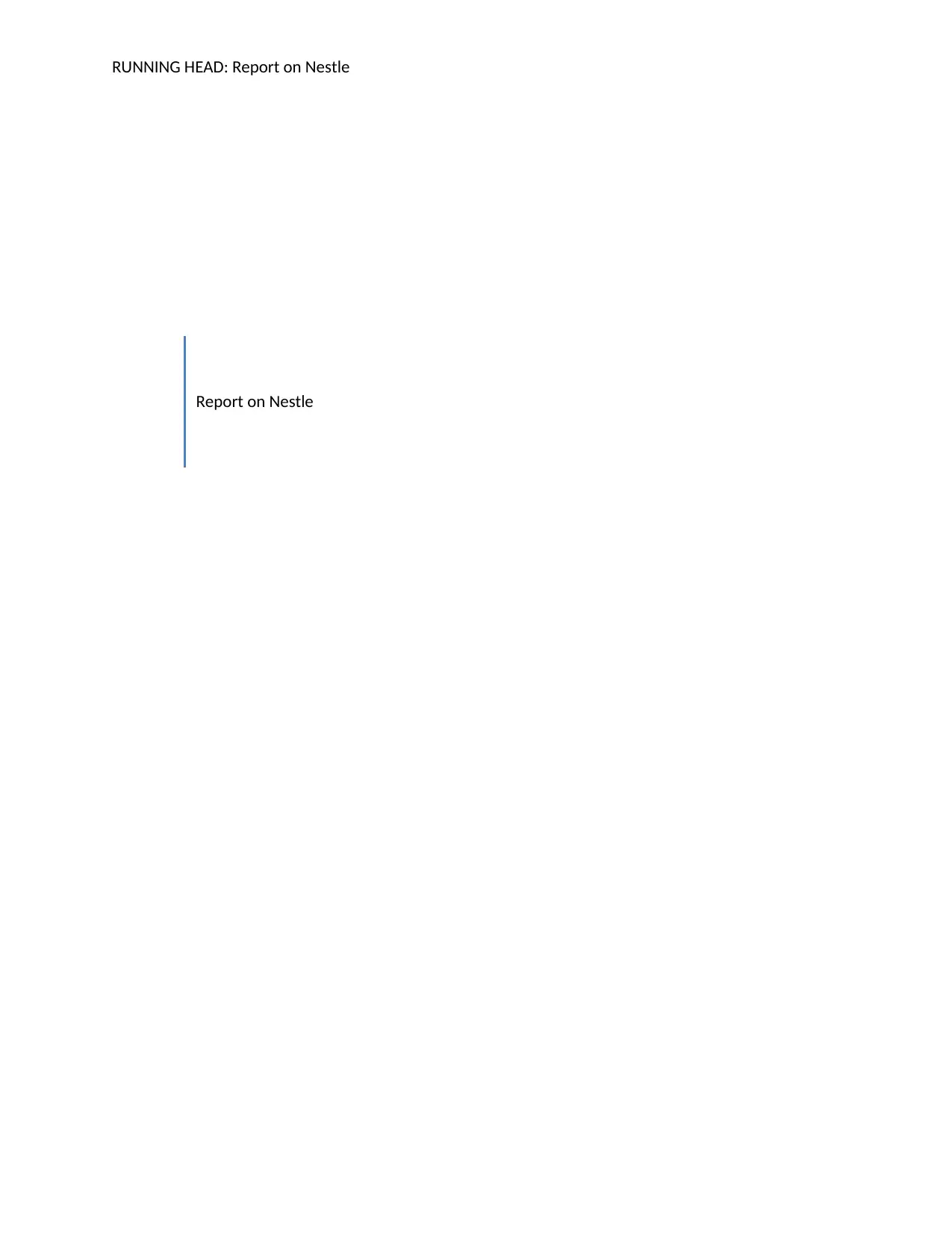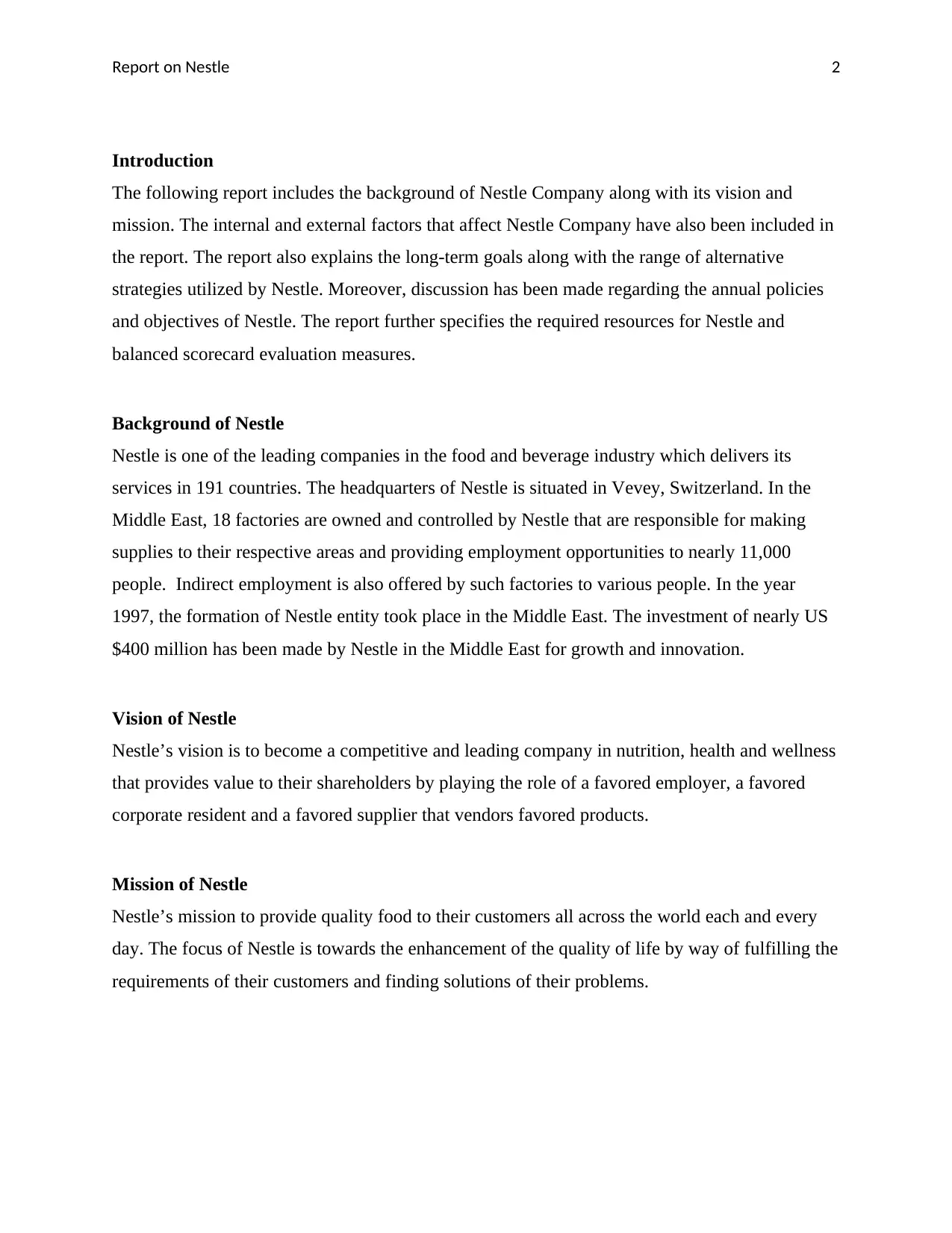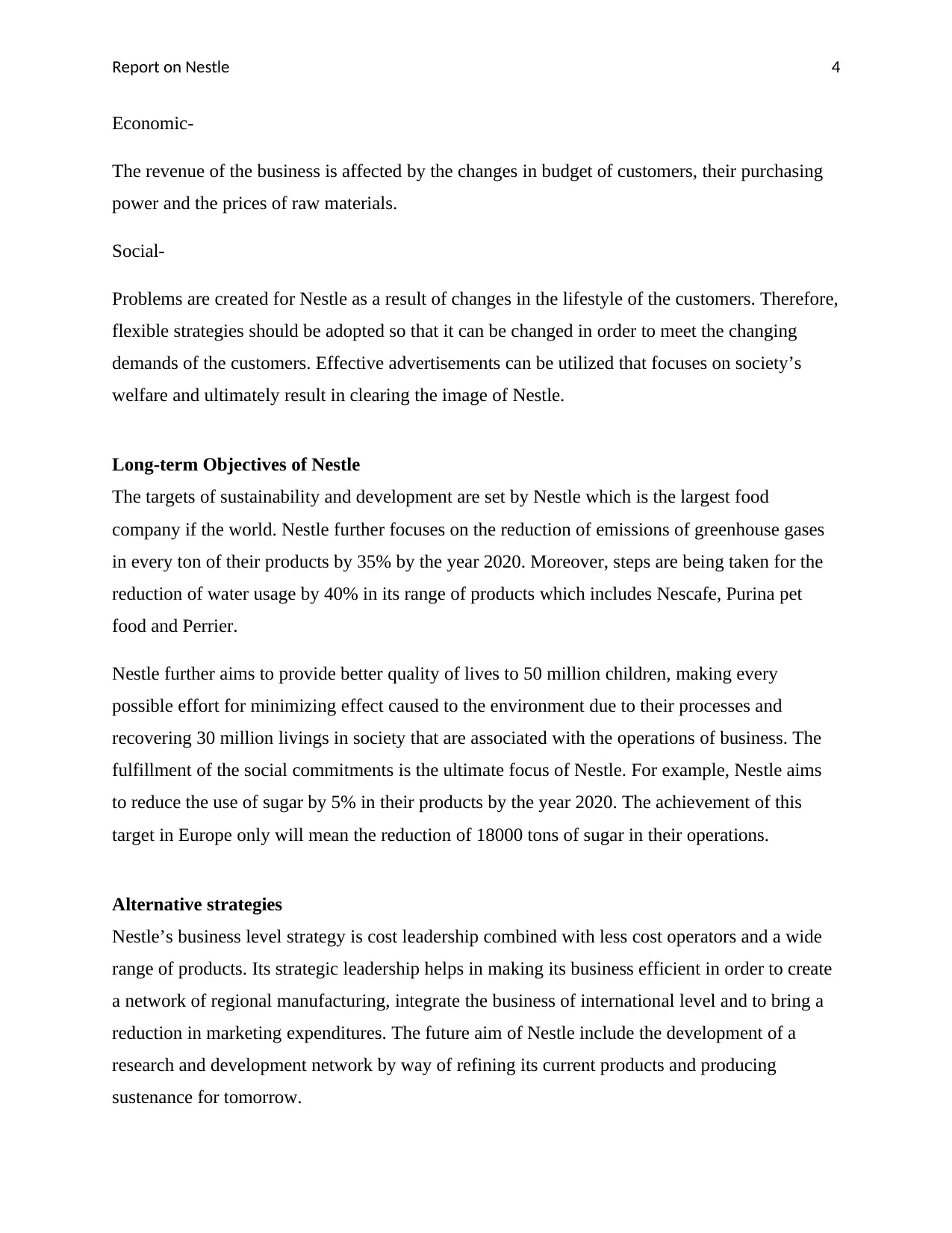Comprehensive Report on Nestle: Company Analysis and Strategies
VerifiedAdded on 2021/04/21
|7
|1321
|311
Report
AI Summary
This report provides a comprehensive analysis of Nestle, a leading company in the food and beverage industry. It begins with an overview of Nestle's background, vision, mission, and core values. The report then delves into the internal and external factors affecting the company, including strengths, weaknesses, political, economic, and social influences. It outlines Nestle's long-term objectives, alternative strategies, annual objectives, and key policies. Furthermore, it discusses the resources available to Nestle, including human, financial, and cultural aspects. The report concludes with an evaluation of Nestle's performance using a balanced scorecard approach, offering a complete understanding of the company's operations and strategic direction.

RUNNING HEAD: Report on Nestle
Report on Nestle
Report on Nestle
Paraphrase This Document
Need a fresh take? Get an instant paraphrase of this document with our AI Paraphraser

Report on Nestle 1
Contents
Introduction......................................................................................................................................2
Background of Nestle......................................................................................................................2
Vision of Nestle...............................................................................................................................2
Mission of Nestle.............................................................................................................................2
Values of Nestle...............................................................................................................................2
Internal factors of Nestle.................................................................................................................3
External Factors of Nestle...............................................................................................................3
Long-term Objectives of Nestle.......................................................................................................4
Alternative strategies.......................................................................................................................4
Annual Objectives of Nestle............................................................................................................5
Policies of Nestle.............................................................................................................................5
Resources of Nestle.........................................................................................................................5
Conclusion.......................................................................................................................................5
Contents
Introduction......................................................................................................................................2
Background of Nestle......................................................................................................................2
Vision of Nestle...............................................................................................................................2
Mission of Nestle.............................................................................................................................2
Values of Nestle...............................................................................................................................2
Internal factors of Nestle.................................................................................................................3
External Factors of Nestle...............................................................................................................3
Long-term Objectives of Nestle.......................................................................................................4
Alternative strategies.......................................................................................................................4
Annual Objectives of Nestle............................................................................................................5
Policies of Nestle.............................................................................................................................5
Resources of Nestle.........................................................................................................................5
Conclusion.......................................................................................................................................5

Report on Nestle 2
Introduction
The following report includes the background of Nestle Company along with its vision and
mission. The internal and external factors that affect Nestle Company have also been included in
the report. The report also explains the long-term goals along with the range of alternative
strategies utilized by Nestle. Moreover, discussion has been made regarding the annual policies
and objectives of Nestle. The report further specifies the required resources for Nestle and
balanced scorecard evaluation measures.
Background of Nestle
Nestle is one of the leading companies in the food and beverage industry which delivers its
services in 191 countries. The headquarters of Nestle is situated in Vevey, Switzerland. In the
Middle East, 18 factories are owned and controlled by Nestle that are responsible for making
supplies to their respective areas and providing employment opportunities to nearly 11,000
people. Indirect employment is also offered by such factories to various people. In the year
1997, the formation of Nestle entity took place in the Middle East. The investment of nearly US
$400 million has been made by Nestle in the Middle East for growth and innovation.
Vision of Nestle
Nestle’s vision is to become a competitive and leading company in nutrition, health and wellness
that provides value to their shareholders by playing the role of a favored employer, a favored
corporate resident and a favored supplier that vendors favored products.
Mission of Nestle
Nestle’s mission to provide quality food to their customers all across the world each and every
day. The focus of Nestle is towards the enhancement of the quality of life by way of fulfilling the
requirements of their customers and finding solutions of their problems.
Introduction
The following report includes the background of Nestle Company along with its vision and
mission. The internal and external factors that affect Nestle Company have also been included in
the report. The report also explains the long-term goals along with the range of alternative
strategies utilized by Nestle. Moreover, discussion has been made regarding the annual policies
and objectives of Nestle. The report further specifies the required resources for Nestle and
balanced scorecard evaluation measures.
Background of Nestle
Nestle is one of the leading companies in the food and beverage industry which delivers its
services in 191 countries. The headquarters of Nestle is situated in Vevey, Switzerland. In the
Middle East, 18 factories are owned and controlled by Nestle that are responsible for making
supplies to their respective areas and providing employment opportunities to nearly 11,000
people. Indirect employment is also offered by such factories to various people. In the year
1997, the formation of Nestle entity took place in the Middle East. The investment of nearly US
$400 million has been made by Nestle in the Middle East for growth and innovation.
Vision of Nestle
Nestle’s vision is to become a competitive and leading company in nutrition, health and wellness
that provides value to their shareholders by playing the role of a favored employer, a favored
corporate resident and a favored supplier that vendors favored products.
Mission of Nestle
Nestle’s mission to provide quality food to their customers all across the world each and every
day. The focus of Nestle is towards the enhancement of the quality of life by way of fulfilling the
requirements of their customers and finding solutions of their problems.
⊘ This is a preview!⊘
Do you want full access?
Subscribe today to unlock all pages.

Trusted by 1+ million students worldwide

Report on Nestle 3
Values of Nestle
Nestle’s values are reflected in their business conduct when the principles of fairness, honesty
and concern for people are followed by them in their operations. Non-negotiable standards have
been set by Nestle by the way it conducts its business and are applicable for everyone who works
with them.
Internal factors of Nestle
Strengths
Distribution System- the diversified products of Nestle have attained success both in urban and
rural market.
Famous- Due to the individual branding of its products, Nestle has been capable of spreading
awareness regarding its products among their customers and has succeeded in become the largest
food company across the globe. The adoption of this strategy was due to the reason that in case
when one brand gets affected like Maggi, the sales of other brand such as Nescafe does not gets
affected.
Weaknesses
Issues- The global brand Nestle also faces legal and consumer issues and fall under a variety of
controversies such as the use of child labor, boycott of baby formula by Nestle, price fixation of
chocolates which ultimately results in the negative image of Nestle.
Various Brand- A single group controls a variety of brands under Nestle which leads to difficulty
in managing the individual brands and has the possibility of creating conflict.
External Factors of Nestle
Political
The expansion of the business of Nestle in different countries requires it to abide by their
respective rules and regulations. Problems are faced by Nestle whenever any changes are made
in the regulations regarding food and beverage. Market analysis should be done by Nestle from
time to time.
Values of Nestle
Nestle’s values are reflected in their business conduct when the principles of fairness, honesty
and concern for people are followed by them in their operations. Non-negotiable standards have
been set by Nestle by the way it conducts its business and are applicable for everyone who works
with them.
Internal factors of Nestle
Strengths
Distribution System- the diversified products of Nestle have attained success both in urban and
rural market.
Famous- Due to the individual branding of its products, Nestle has been capable of spreading
awareness regarding its products among their customers and has succeeded in become the largest
food company across the globe. The adoption of this strategy was due to the reason that in case
when one brand gets affected like Maggi, the sales of other brand such as Nescafe does not gets
affected.
Weaknesses
Issues- The global brand Nestle also faces legal and consumer issues and fall under a variety of
controversies such as the use of child labor, boycott of baby formula by Nestle, price fixation of
chocolates which ultimately results in the negative image of Nestle.
Various Brand- A single group controls a variety of brands under Nestle which leads to difficulty
in managing the individual brands and has the possibility of creating conflict.
External Factors of Nestle
Political
The expansion of the business of Nestle in different countries requires it to abide by their
respective rules and regulations. Problems are faced by Nestle whenever any changes are made
in the regulations regarding food and beverage. Market analysis should be done by Nestle from
time to time.
Paraphrase This Document
Need a fresh take? Get an instant paraphrase of this document with our AI Paraphraser

Report on Nestle 4
Economic-
The revenue of the business is affected by the changes in budget of customers, their purchasing
power and the prices of raw materials.
Social-
Problems are created for Nestle as a result of changes in the lifestyle of the customers. Therefore,
flexible strategies should be adopted so that it can be changed in order to meet the changing
demands of the customers. Effective advertisements can be utilized that focuses on society’s
welfare and ultimately result in clearing the image of Nestle.
Long-term Objectives of Nestle
The targets of sustainability and development are set by Nestle which is the largest food
company if the world. Nestle further focuses on the reduction of emissions of greenhouse gases
in every ton of their products by 35% by the year 2020. Moreover, steps are being taken for the
reduction of water usage by 40% in its range of products which includes Nescafe, Purina pet
food and Perrier.
Nestle further aims to provide better quality of lives to 50 million children, making every
possible effort for minimizing effect caused to the environment due to their processes and
recovering 30 million livings in society that are associated with the operations of business. The
fulfillment of the social commitments is the ultimate focus of Nestle. For example, Nestle aims
to reduce the use of sugar by 5% in their products by the year 2020. The achievement of this
target in Europe only will mean the reduction of 18000 tons of sugar in their operations.
Alternative strategies
Nestle’s business level strategy is cost leadership combined with less cost operators and a wide
range of products. Its strategic leadership helps in making its business efficient in order to create
a network of regional manufacturing, integrate the business of international level and to bring a
reduction in marketing expenditures. The future aim of Nestle include the development of a
research and development network by way of refining its current products and producing
sustenance for tomorrow.
Economic-
The revenue of the business is affected by the changes in budget of customers, their purchasing
power and the prices of raw materials.
Social-
Problems are created for Nestle as a result of changes in the lifestyle of the customers. Therefore,
flexible strategies should be adopted so that it can be changed in order to meet the changing
demands of the customers. Effective advertisements can be utilized that focuses on society’s
welfare and ultimately result in clearing the image of Nestle.
Long-term Objectives of Nestle
The targets of sustainability and development are set by Nestle which is the largest food
company if the world. Nestle further focuses on the reduction of emissions of greenhouse gases
in every ton of their products by 35% by the year 2020. Moreover, steps are being taken for the
reduction of water usage by 40% in its range of products which includes Nescafe, Purina pet
food and Perrier.
Nestle further aims to provide better quality of lives to 50 million children, making every
possible effort for minimizing effect caused to the environment due to their processes and
recovering 30 million livings in society that are associated with the operations of business. The
fulfillment of the social commitments is the ultimate focus of Nestle. For example, Nestle aims
to reduce the use of sugar by 5% in their products by the year 2020. The achievement of this
target in Europe only will mean the reduction of 18000 tons of sugar in their operations.
Alternative strategies
Nestle’s business level strategy is cost leadership combined with less cost operators and a wide
range of products. Its strategic leadership helps in making its business efficient in order to create
a network of regional manufacturing, integrate the business of international level and to bring a
reduction in marketing expenditures. The future aim of Nestle include the development of a
research and development network by way of refining its current products and producing
sustenance for tomorrow.

Report on Nestle 5
Annual Objectives of Nestle
The business objectives and marketing objectives are aligned with each other. The objective of
Nestle is to attain the position of best branded and largest manufacturer of food all across the
globe along with assuring the highest quality in its products.
The attainment of compatibility is also aimed by Nestle with the global volunteer standards on
global management system. It also focuses on trust building with government authorities,
customers and business partners.
Policies of Nestle
Policy of Nestle is to make sure that the board members, employees and external shareholders,
who are in possession of any price sensitive or confidential information, do not disclose it and be
aware regarding the law imposed on the disclosure of such information. It is the responsibility of
all the shareholders to safeguard the confidential information.
Resources of Nestle
The resources of Nestle are classified into tangible, intangible, financial and human resources.
Human Resources- The employees and staff are the main reason behind the success and growth
of Nestle. The productivity and well-being of Nestle is influenced by its staff members.
Culture- The satisfaction of stakeholders and encouraging innovation comprise the culture of
Nestle.
For the purpose of business decision making, the use of balanced scorecard is made for
managing the performance. It is the method with the help of which progress of organizational
goal is monitored.
Conclusion
Nestle is one of the leading manufacturer and seller of food and beverages products having its
operations in 191 countries. Its vision is to attain the position of world’s leading company that
provides quality products to its consumers. Internal factor analysis of Nestle provides that the
Annual Objectives of Nestle
The business objectives and marketing objectives are aligned with each other. The objective of
Nestle is to attain the position of best branded and largest manufacturer of food all across the
globe along with assuring the highest quality in its products.
The attainment of compatibility is also aimed by Nestle with the global volunteer standards on
global management system. It also focuses on trust building with government authorities,
customers and business partners.
Policies of Nestle
Policy of Nestle is to make sure that the board members, employees and external shareholders,
who are in possession of any price sensitive or confidential information, do not disclose it and be
aware regarding the law imposed on the disclosure of such information. It is the responsibility of
all the shareholders to safeguard the confidential information.
Resources of Nestle
The resources of Nestle are classified into tangible, intangible, financial and human resources.
Human Resources- The employees and staff are the main reason behind the success and growth
of Nestle. The productivity and well-being of Nestle is influenced by its staff members.
Culture- The satisfaction of stakeholders and encouraging innovation comprise the culture of
Nestle.
For the purpose of business decision making, the use of balanced scorecard is made for
managing the performance. It is the method with the help of which progress of organizational
goal is monitored.
Conclusion
Nestle is one of the leading manufacturer and seller of food and beverages products having its
operations in 191 countries. Its vision is to attain the position of world’s leading company that
provides quality products to its consumers. Internal factor analysis of Nestle provides that the
⊘ This is a preview!⊘
Do you want full access?
Subscribe today to unlock all pages.

Trusted by 1+ million students worldwide

Report on Nestle 6
strengths of Nestle include its fame and range of products. Moreover, its weaknesses include its
handling of products rangeunder single group.
strengths of Nestle include its fame and range of products. Moreover, its weaknesses include its
handling of products rangeunder single group.
1 out of 7
Related Documents
Your All-in-One AI-Powered Toolkit for Academic Success.
+13062052269
info@desklib.com
Available 24*7 on WhatsApp / Email
![[object Object]](/_next/static/media/star-bottom.7253800d.svg)
Unlock your academic potential
Copyright © 2020–2025 A2Z Services. All Rights Reserved. Developed and managed by ZUCOL.




